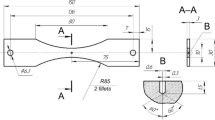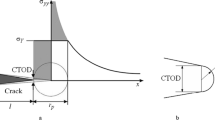Abstract
It is known that determination of the service life of structures under loading at elevated temperatures is carried out on the basis of time-consuming creep and fatigue tests. It is not possible to do without the tests now; however, the problem is to organize them in a more rational way from the technical and economical points of view. For the achievement of this purpose a method is offered. Various alloys based on the same metal are grouped by the structural criterion using the yield stress as an additional characteristic of the metal. It is convenient since the yield stress value is specified by the same system of obstacles, interfering with the movement of dislocations, on which other properties of the alloy depend. The physical relations descriptive of the structural parameters and yield stress are the most reliable ones. The physical model of metal or relations descriptive of its mechanical properties are transformed in such a manner that they become valid for the group of alloys as a whole. The correlation between the properties and the yield stress is confirmed with a high statistical reliability. As a result, the mean value and the scatter of the characteristics of each alloy can be determined directly using the correlation dependences for an appropriate alloy group. By means of the offered method it is possible to calculate directly the alloy low-cycle life. An example verifying the utility of the method is presented.
Similar content being viewed by others
References
K. Lehofer, “Relations between the structure and the creep properties of precipitation hardened alloys,” CSc (Ph.D.) dissertation presented to the Hungarian Academy of Sciences, 1970 (in Hungarian).
K. Lehofer, “New method for the evaluation of recovery creep properties.,”Proc. 4th Conf. on Dimensioning, Budapest, 1971. Publishing House of the Hungarian Academy of Sciences, p. 89.
K. Lehofer, “Determination of the service life decreasing effect of changing temperature on the basis of creep test data...,”Eigenschaften warmfester Stähle. Bd. 1. Düsseldorf, 1972. Hrsg.: VDEh., S. III/2.
K. Lehofer, “Determination problem of service life decreasing effect of changing temperature and load,” Discussion report. Int. Conf. on Creep and Fatigue in Elevated Temperature Applications, Sheffield, 1974.
K. Lehofer, “Determination of fatigue life at elevated temperature on the basis of the creep laws,”5th Int. Symp. on Creep-Resistant Metallic Materials, 1976. Vsetin. Vol. II. p. 392. and Gep, Vol. XXIX. (1977) 3. p. 100 (in Hungarian).
K. Lehofer and T. Sipos, “Influence of neutron radiation on the structure and the properties of metals,” Gep, Vol. XXX. (1978) 1. p. 6 (in Hungarian).
K. Lehofer, “Yield point as a material structure peculiarity,”Proc. 5th Symp. on Metallography, Part 2, p. 23, 1983, Vysoké Tatry, CSR.
K. Lehofer, “Estimation of the residual life,”Proc. 7th Int. Symp. on Creep-Resistant Metallic Materials, Brno, 1986, p. 335.
J. E. Dorn, “Some fundamental experiments on high-temperature creep,” Proc. of a symposium held at the NPL 31 May–2 June, 1954. London. 1956. pp. 89–132.
P. W. Davies and B. Wilshire,Structural Processes in Creep, London (1961), p. 34.
R. Viswanathan,Metals Technology,1, No. 6, 284 (1974).
W. D. Nix, D. K. Matlock, and R. J. Dimelfi, “A model for creep fracture based on the plastic growth of cavities.,”Acta Metallurgica,25, No. 5, 495 (1977).
Ergebnisse Deutscher Zeitstandversuche Langer Dauer.Hrsg.: Verein Deutscher Eisenhütten-leute, Düsseldorf, 1969.
G. F. Harrison and G. P. Tilly, “The static and cycle properties of three forms of a cast nickel alloy,”Int. Conf. on Creep and Fatigue in Elevated Temperature Applications, Sheffield, 1974. C/222/73.
G. Thomas and R. A. T. Dawson,Proc. Int. Conf. on Creep, Sheffield, 1980, Vol. 1, p. 167.
R. Pech and J. Sedlacek,Symp. on Physical Metallurgical Problems, Plzen, 1970, Vol. 1, p. 138.
Author information
Authors and Affiliations
Additional information
Published inProblemy Prochnosti, Nos. 1–2, pp. 126–136, January–February, 1995.
Rights and permissions
About this article
Cite this article
Lehofer, K. Coherent view of creep and fatigue. Strength Mater 27, 88–95 (1995). https://doi.org/10.1007/BF02206417
Issue Date:
DOI: https://doi.org/10.1007/BF02206417




